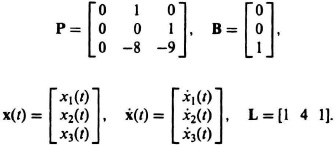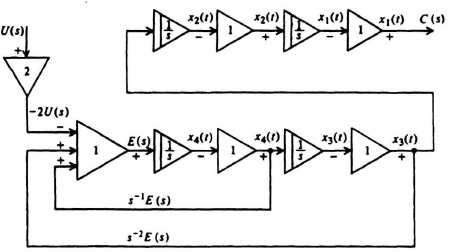2.22. STATE-VARIABLE DIAGRAM
The state-variable diagram provides a physical picture that is useful in understanding the state-variable concept. In addition, the differential equations relating the state variables are easily obtained by inspection of the diagram. A state-variable diagram consists of integrators, summing devices, and amplifiers. Outputs from the integrators denote the state variables. It should be noted that the state-variable diagram is the same as an analog computer simulation diagram [15].
Example 1. As an example of determining the state-variable diagram, consider a system whose transfer function is given by
Dividing numerator and denominator by s3, to obtain the result in terms of integrators:
Defining the error node of the control system to be E(s),
Eq. (2.223) may be rewritten as follows:
From Eq. (2.225) and the relation
the state-variable diagram can easily be obtained as indicated in Figure 2.30*. The state variables are indicated in the diagrams as x1(t), x2(t), and x3(t). Also, the differential equations relating the state variables are easily obtained from Figure 2.30 by inspection. From the state-variable diagram, the differential equations relating the state variables are as follows:
Therefore, the entire system can be described in phase-variable canonical form by
Figure 2.30 State-variable diagram for system where P(s) = (s2 + 4s + 1)/(s3 + 9s2 + 8s).

The output c(t) can be obtained by a linear combination of the three state variables as follows:
Example 2. As a second example for determining the state-variable diagram, consider a system whose transfer function is given by
Dividing through by s4 we obtain
Defining
![]()
Eq. may be rewritten us
From Eq. (2.233) and the relation
the state-variable diagram for this system can easily be obtained (see Figure 2.31). The state variables are referred to as x1(t), x2(t), x3(t), and x4(t). They are defined as
The differential equations relating the state variables are as follows:
Figure 2.31 State-variable diagram for system where P(s) = [2/s2(s2 + s + 1)].
The corresponding phase-variable canonical form is given by
where

From this discussion it can be seen that it is possible to apply the signal-flow graph technique to state-variable analysis. Mason’s theorem can be applied to the signal-flow graph which is obtained directly by inspection of the state-variable diagram. The signal-flow graph also provides a physical interpretation of the state-variable concept since its nodes actually represent the different states of the system.
For example, the signal-flow graphs corresponding to the state-variable diagrams of Figures 2.30 and 2.31 are given in Figures 2.32 and 2.33, respectively. The physical meaning of system state is quite clear from these diagrams.





